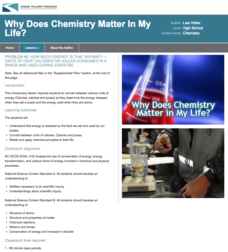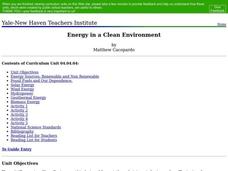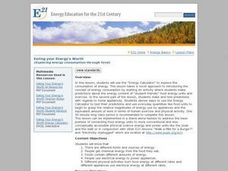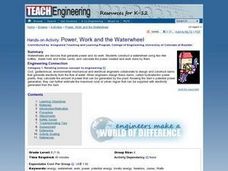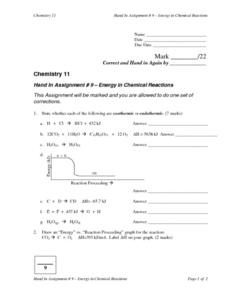Teach Engineering
Energy Basics
Power up your lessons with an energetic resource. Scholars learn about work, force, energy, and power. They consider the relationships between these quantities through hockey puck scenarios and make calculations using formulas.
University of Georgia
The Power of Peanuts
Measure the amount of energy in a peanut by igniting a chemical reaction. Classes use a laboratory setup to burn a peanut and measure the amount of heat it releases through a temperature analysis. They calculate the number of Joules of...
Kenan Fellows
How Much Energy Is That Anyway?
The fifth lesson in the six part series introduces units of energy including calories, Calories, and joules. Scholars determine the energy released when eating a snack and during activity.
Curated OER
Energy: The Universal Currency
Science stars examine the concept of energy by thinking about everyday situations. The lesson plan is incohesive. It lists goals for the student, but doesn't address all of them in the content. The best use of this resource would simply...
Curated OER
Measuring Solar Energy
Young scholars study solar energy and how to measure it. In this energy sources instructional activity students complete a lab, obtain data and use that to convert surface temperature to energy.
Curated OER
Energy in a Clean Environment
Students identify and describe the different types of energy and how it is transferred. In this energy activity students complete several activities including how to calculate joules, adding up wattage, and create a presentation on...
Curated OER
Atomic Emission Spectra and the Bohr Model of the Atom
High schoolers investigate the wavelengths of spectra lines for common atoms. In this atomic emission spectra lesson plan, students use a transformer and diffraction grating to observe the emission spectra of various atoms. They find the...
Curated OER
Energy in a Clean Environment
Students examine the efficiency of each alternative energy source as well as what limitations exist in terms of extracting the usable energy. They determine which energy source is most effective to the economy and the environment in the...
Curated OER
Ice Cream Lab
I scream, you scream, we all scream for ice cream! Even high schoolers enjoy making ice cream. This laboratory exercise has them record the temperature changes throughout the process of liquid becoming solid, graph the results, and...
Curated OER
Practice Test Chapter 12: Energy Changes in Chemical Reactions
In this chemistry practice test worksheet, students review their knowledge of energy changes in chemical reactions as they answer 17 multiple choice and short answer questions.
Curated OER
How Do Clouds Affect Radiative Energy
Students graph the upwelling and downwelling of shortwave radiation. They create a data table with the information. Students compute the Watts per square meter. They discuss their results and whether or not cloud type affects daily...
Curated OER
Eating your Energy's Worth
Students calculate the amount of electrical energy used in a week in food units. They create ways to reduce energy use. Students discuss the different forms and sources of energy. They discuss how people use electrical energy to power...
Curated OER
Bounce!
Pupils investigate the relationship between potential and kinetic energy. In this energy lesson students investigate the height a ball will bounce when dropped from various heights.
Curated OER
Ramp and Review
Young scholars participate in an activity in which they observe a ball as it rolls down an incline into a cup. They take measurements and use equations that describe the concepts of mechanical energy, work and power, momentum, and...
Curated OER
Walk a Mile for a Burger?
Students are introduced to the pedometer, and use this tool to associate physical activity (physical energy) with calories burned (chemical energy). They comprehend the making and burning of energy.
Bonneville
Passive Solar Water Heating
Put empty milk jugs to good use. Scholars consider the characteristics they might change about a milk jug to improve light absorption. They design a passive solar water heater using the milk jug and then measure the temperature change in...
Curated OER
Measuring Thermal Energy Transfer
Learners conduct an experiment to calculate and quantify heat transfer. They conduct the experiment, and complete a data and lab conclusion sheet.
Santa Monica College
Flame Tests of Metal Cations
Scientists used flame tests to identify elements long before the invention of emission spectroscopy. Young chemists observe a flame test of five metal cations in the fourth instructional activity of an 11-part series. Individuals then...
Curated OER
Energy of Activation
High schoolers determine the activation energy of a chemical reaction.
Curated OER
Power, Work and the Waterwheel
Students use a two-liter bottle, dowel rod and index cards to design and construct a water wheel. They then calculate the power created and measure the work done by the water wheel in Watts and Joules.
Curated OER
Heat: Mini Unit
Students experiment with heat. In this physical science lesson, students engage in hands-on activities to develop concepts related to heat. Students offer explanations for their observations using given vocabulary.
Curated OER
Energy in Chemical Reactions
In this chemical reaction worksheet, students determine if reactions are exothermic or endothermic. Students define enthalpy and calculate how much heat is released or absorbed during reactions. This worksheet has 1 matching, 1 fill in...
Kenan Fellows
How Much Heat Can a Phase Change Produce?
Scholars learn about heat release in phase changes. They perform calculations as they compare and contrast a science fiction passage and a home heating application.
Virginia Department of Education
Molar Heat of Fusion for Water
How can you describe heat of fusion in a way the class understands and relates the importance of this concept to present day issues? In this third lesson of the series, learners conduct an experiment, demonstrating the flow of heat...


